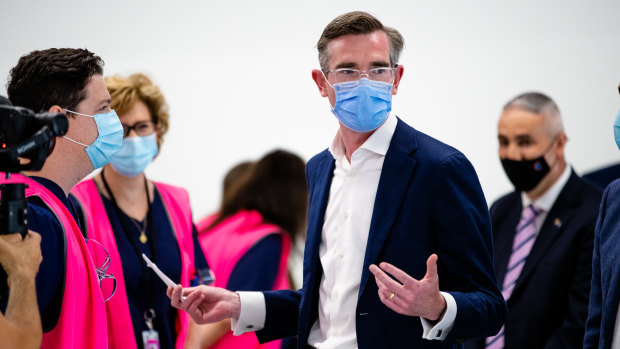This was published 3 years ago
NSW hits 90 per cent double-dose vaccination rate
By Mary Ward
Ninety per cent of people aged 16 and over in NSW have now received both doses of a COVID-19 vaccine, as the state sets its sights on a 95 per cent rate.
Federal government data released on Tuesday afternoon showed 90.12 per cent of the age group were double-dosed, with 93.97 per cent having received at least one shot.
The rate is 75.6 per cent of the state’s total population vaccinated, including doses administered to children aged 12 to 15, surpassing many countries who started their rollouts months before Australia.
Just over 67 per cent of the UK population is fully vaccinated and the figure in the US is about 57 per cent, according to the Our World in Data vaccination tracker. Seven countries have higher double-dose rates than NSW: the UAE, Portugal, Singapore, Chile, Cambodia, Spain and South Korea.
NSW is the second jurisdiction in Australia to achieve 90 per cent, after the ACT reached that milestone on October 27 (its rate is now more than 95 per cent).
The state hit 80 per cent double-dose in the age group in mid-October.

Booster push: NSW Premier Dominic Perrottet at the new Granville Centre vaccination clinic on Monday. Credit: Edwina Pickles
It plans to ease restrictions for unvaccinated people when it reaches 95 per cent coverage or on December 15, whichever comes first.
“Across NSW it’s pleasing to see those high rates of vaccination continue to inch upwards to our objective of achieving 95 per cent double vaccination,” Chief Health Officer Kerry Chant said, encouraging people to book in for a booster if six months had passed since their second shot.
As the state’s overall vaccination rate climbs, only a handful of council areas now have double-dose rates below 80 per cent.
According to figures released on Monday, 85.5 per cent of residents in Byron Shire – known for its low childhood vaccination rates and large number of vaccine refusers – have received a first dose and 75 per cent are fully vaccinated.
Professor Alexandra Martiniuk, an epidemiologist at the University of Sydney, said 90 per cent was an “amazing” achievement given coverage was in the single digits before the state’s Delta wave. However, she said it was important for people to not confuse the milestone with “herd immunity” from the virus.
“People always said we would hit ‘herd immunity’ at 90 per cent or 95 per cent – but this is the 16-and-over population, so we are not there yet,” she stressed.
While NSW’s Indigenous vaccination rates are higher than other states, there is still a gap between rates in these communities and the general population.
An outbreak in Moree in the state’s north-west is currently mostly affecting unvaccinated Aboriginal people.
“We need uniform vaccination rates, and right now they’re not – regional rates are lower, and groups we have reasons for wanting to protect – like the Aboriginal population – are also lower,” Professor Martiniuk said, noting there were still groups left to be vaccinated in order for the state to hit 95 per cent.
Professor Emma McBryde, an infectious diseases physician and mathematician at James Cook University, said there would be a limited difference in the impact of a 90 per cent as opposed to a 95 per cent double-dose rate. She agreed neither would offer herd immunity and said the disease burden on NSW’s hospital system had already been significantly lessened.
The high rate of coverage has continued to reduce COVID-19 hospitalisations in the state. On Tuesday, there were 254 cases in hospital and 42 in intensive care.
An analysis of the vaccination status of virus cases conducted by the National Centre for Immunisation Research and Surveillance released this week showed people who were not vaccinated were 16 times more likely to require intensive care treatment.
This month, four unvaccinated people aged under 60 have died from the virus, including a man in his 50s from south-west Sydney whose death was announced on Tuesday.
with Pallavi Singhal